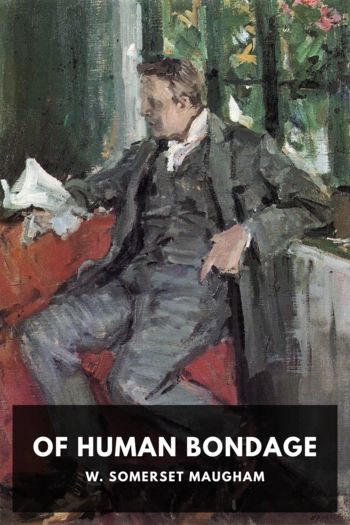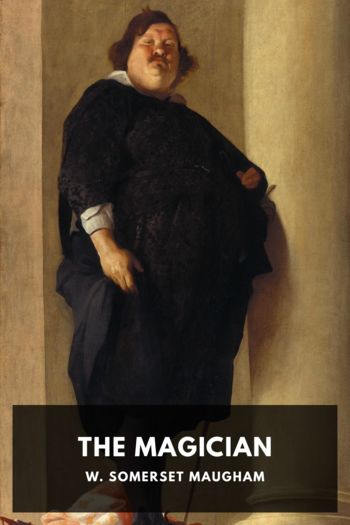Of Human Bondage by W. Somerset Maugham (classic english novels .TXT) 📕

Description
Considered by many to be Maugham’s masterpiece, Of Human Bondage is a semi-autobiographical coming-of-age tale. The novel follows Philip, a sensitive young man interested in literature and art, as he searches for happiness in London and Paris. Philip, the ostensible stand-in for Maugham, suffers from a club foot, a physical representation of the stutter that Maugham himself suffered. Philip’s love life, a central aspect to the book, also mirrors Maugham’s own stormy affairs.
Maugham originally titled the book “Beauty from Ashes” before settling on the final title, taken from a section of Spinoza’s Ethics in which he discusses how one’s inability to control one’s emotions results in a form of bondage.
Read free book «Of Human Bondage by W. Somerset Maugham (classic english novels .TXT) 📕» - read online or download for free at americanlibrarybooks.com
- Author: W. Somerset Maugham
Read book online «Of Human Bondage by W. Somerset Maugham (classic english novels .TXT) 📕». Author - W. Somerset Maugham
“But when you try to get that you become literary,” said Lawson, interrupting. “Let me paint the man like Manet, and the intention of his soul can go to the devil.”
“That would be all very well if you could beat Manet at his own game, but you can’t get anywhere near him. You can’t feed yourself on the day before yesterday, it’s ground which has been swept dry. You must go back. It’s when I saw the Grecos that I felt one could get something more out of portraits than we knew before.”
“It’s just going back to Ruskin,” cried Lawson.
“No—you see, he went for morality: I don’t care a damn for morality: teaching doesn’t come in, ethics and all that, but passion and emotion. The greatest portrait painters have painted both, man and the intention of his soul; Rembrandt and El Greco; it’s only the second-raters who’ve only painted man. A lily of the valley would be lovely even if it didn’t smell, but it’s more lovely because it has perfume. That picture”—he pointed to Lawson’s portrait—“well, the drawing’s all right and so’s the modelling all right, but just conventional; it ought to be drawn and modelled so that you know the girl’s a lousy slut. Correctness is all very well: El Greco made his people eight feet high because he wanted to express something he couldn’t get any other way.”
“Damn El Greco,” said Lawson, “what’s the good of jawing about a man when we haven’t a chance of seeing any of his work?”
Clutton shrugged his shoulders, smoked a cigarette in silence, and went away. Philip and Lawson looked at one another.
“There’s something in what he says,” said Philip.
Lawson stared ill-temperedly at his picture.
“How the devil is one to get the intention of the soul except by painting exactly what one sees?”
About this time Philip made a new friend. On Monday morning models assembled at the school in order that one might be chosen for the week, and one day a young man was taken who was plainly not a model by profession. Philip’s attention was attracted by the manner in which he held himself: when he got on to the stand he stood firmly on both feet, square, with clenched hands, and with his head defiantly thrown forward; the attitude emphasised his fine figure; there was no fat on him, and his muscles stood out as though they were of iron. His head, close-cropped, was well-shaped, and he wore a short beard; he had large, dark eyes and heavy eyebrows. He held the pose hour after hour without appearance of fatigue. There was in his mien a mixture of shame and of determination. His air of passionate energy excited Philip’s romantic imagination, and when, the sitting ended, he saw him in his clothes, it seemed to him that he wore them as though he were a king in rags. He was uncommunicative, but in a day or two Mrs. Otter told Philip that the model was a Spaniard and that he had never sat before.
“I suppose he was starving,” said Philip.
“Have you noticed his clothes? They’re quite neat and decent, aren’t they?”
It chanced that Potter, one of the Americans who worked at Amitrano’s, was going to Italy for a couple of months, and offered his studio to Philip. Philip was pleased. He was growing a little impatient of Lawson’s peremptory advice and wanted to be by himself. At the end of the week he went up to the model and on the pretence that his drawing was not finished asked whether he would come and sit to him one day.
“I’m not a model,” the Spaniard answered. “I have other things to do next week.”
“Come and have luncheon with me now, and we’ll talk about it,” said Philip, and as the other hesitated, he added with a smile: “It won’t hurt you to lunch with me.”
With a shrug of the shoulders the model consented, and they went off to a crèmerie. The Spaniard spoke broken French, fluent but difficult to follow, and Philip managed to get on well enough with him. He found out that he was a writer. He had come to Paris to write novels and kept himself meanwhile by all the expedients possible to a penniless man; he gave lessons, he did any translations he could get hold of, chiefly business documents, and at last had been driven to make money by his fine figure. Sitting was well paid, and what he had earned during the last week was enough to keep him for two more; he told Philip, amazed, that he could live easily on two francs a day; but it filled him with shame that he was obliged to show his body for money, and he looked upon sitting as a degradation which only hunger could excuse. Philip explained that he did not want him to sit for the figure, but only for the head; he wished to do a portrait of him which he might send to the next Salon.
“But why should you want to paint me?” asked the Spaniard.
Philip answered that the head interested him, he thought he could do a good portrait.
“I can’t afford the time. I grudge every minute that I have to rob from my writing.”
“But it would only be in the afternoon.





Comments (0)